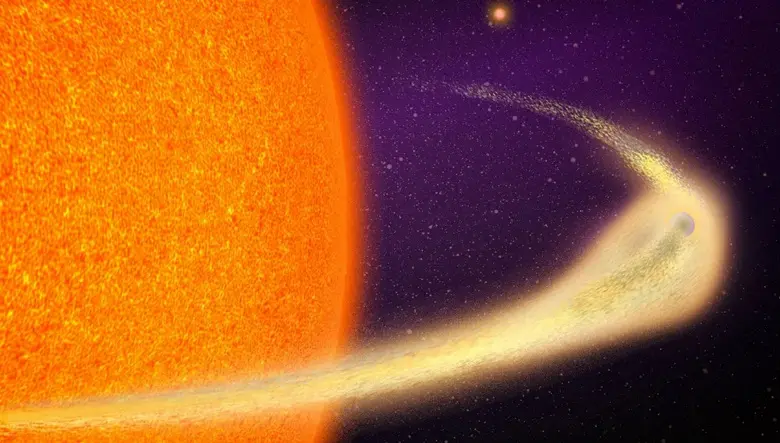A team of astronomers from NASA and the Massachusetts Institute of Technology has discovered an exoplanet that orbits so close to its star that its surface is turning into magma and evaporating into space. The planet was detected by NASA’s Transiting Exoplanet Survey Satellite (TESS). Researchers report that it is literally falling apart as it circles its star. Located about 140 light-years from Earth in the constellation Pegasus, the doomed planet BD+05 4868 Ab completes an orbit every 30.5 hours, extremely close to its star. With each orbit, BD+05 4868 Ab leaves behind a blazing trail of molten rock, reminiscent of a comet. Scientists describe this rare sight as an “exoplanet in the final stages of its destruction.”
Remarkably, with each rotation, heating up to 1600 °C, the planet sheds molten rock weighing as much as Mount Everest. What else did the team reveal? “The length of the tail is colossal: it stretches for 9 million kilometers, which is about half of the planet’s entire orbit,” said Mark Hon, a postdoctoral researcher at MIT. He described it as an epic disintegration unfolding in real-time. Scientists predict that the complete breakdown of the planet could take between one to two million years. “We are fortunate to have discovered it just as it is disappearing. It’s as if it’s on its last breath,” noted Avi Shporer, a co-author of the discovery from the TESS space observatory team.
Previously, researchers had identified only three disintegrating planets among more than 6,000 known exoplanets. Each of these leaves behind a characteristic comet-like tail of debris. However, BD+05 4868 Ab boasts the longest tail of the three, according to Live Science. “This means its evaporation will be the most catastrophic, and it will vanish much faster than the other planets,” Hon explained.
Because BD+05 4868 Ab orbits in dangerously close proximity to its star, its transit—a dip in starlight that occurs when the planet passes in front of its star—is particularly bright and pronounced. This makes the planet an ideal target for observations by NASA’s James Webb Space Telescope (JWST), whose sensitive instruments can detect subtle changes in starlight, determining the chemical composition of the evaporating rock. “The shape of the transit is typical for a comet with a long tail. Except that this tail is unlikely to contain volatile gases and ice, as one would typically expect from a true comet; they wouldn’t be able to survive for long in such close proximity to their host star. However, mineral grains evaporating from the planet’s surface can persist long enough to form such a characteristic tail,” Hon explained.
Meanwhile, Shporer suggested that the planet is likely disintegrating due to its small mass. “This is a very small object (between the size of Mercury and the Moon) with very weak gravity, so it easily loses a lot of mass, which further weakens its gravity,” he said. This is an uncontrollable process, and it is becoming increasingly dramatic for the planet. The team plans to conduct follow-up observations this summer using JWST. “This will be a unique opportunity to directly measure the internal composition of a rocky planet, which could tell us a lot about the diversity and potential habitability of Earth-like planets beyond our solar system,” Hon noted.
For now, researchers are searching for more similar examples in TESS data. Shporer stated, “We are currently trying to initiate a search for such objects. These are strange objects, and the shape of their signal changes over time, which makes them difficult to detect. But this is something we are actively working on.” The findings of the study were published by Space.

